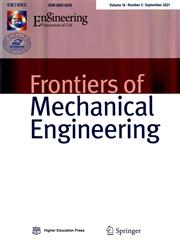Environmental particle rebound/deposition modeling in engine hot sections
IF 4
2区 工程技术
Q1 ENGINEERING, MECHANICAL
引用次数: 1
Abstract
The aircraft engine hot section is most vulnerable and failure prone to environmental particle ingestion, which, particularly for helicopters, can cause detrimental effects ranging from reduced performance to complete engine failure. The objective of this work is to develop an analytical tool to assess environmental particle impact on engine hot sections. The current state of the art in experimental and analytical research on environmental particle ingestion related to engine hot sections was reviewed, with emphasis on sand particles. From these efforts, the available experimental data for model calibration were identified, and an innovative particle rebound/deposition model has been developed. A semi-empirical approach is selected to model particles bouncing off metal surfaces, where the coefficients of restitution measured in a temperature range of 297–1323 K are used to calculate particle bounce-back velocity components. The developed deposition model is based on non-dimensional parameter analysis over more than seventy experiments related to particle deposition in engine hot sections. The metal surface temperature, one of two critical parameters in particle deposition, is also included in the model. The model was successfully implemented into commercial software and checked step by step. It was calibrated by two cases: sand [Arizona road dust (ARD)] particle impingement on a circular plate and Mt. St. Helens volcanic ash impinging on a first-stage air-cooled nozzle guide vane (NGV). For the former case, the calibrated model predicts fairly well the variation of particle deposition rate with flow/particle temperature. The latter case indicates that the particle deposition rate at engine operating conditions can be assessed by the developed model. Due to the lack of experimental data that would permit a full calibration/validation, for the time being the model can be only used under limited conditions. As additional relevant experimental data appears, the model will be continuously improved.发动机热段的环境颗粒反弹/沉积建模
飞机发动机的热段是最脆弱的,容易受到环境颗粒摄入的影响,特别是对于直升机来说,这可能会导致从性能下降到完全故障的有害影响。这项工作的目的是开发一种分析工具来评估环境颗粒对发动机热段的影响。综述了发动机热段环境颗粒摄入的实验和分析研究现状,重点介绍了沙粒的研究现状。通过这些努力,确定了可用于模型校准的实验数据,并开发了一种创新的颗粒回弹/沉积模型。采用半经验方法模拟粒子在金属表面的反弹,利用297 ~ 1323 K温度范围内的恢复系数计算粒子的反弹速度分量。建立的沉积模型是基于对70多个发动机热段颗粒沉积试验的无量纲参数分析。金属表面温度作为颗粒沉积的两个关键参数之一,也被纳入模型中。该模型已成功应用于商业软件中,并进行了逐步验证。通过两种情况进行校准:砂[亚利桑那州道路粉尘(ARD)]颗粒撞击圆形板和St. Helens火山火山灰撞击第一级风冷喷嘴导叶(NGV)。对于前一种情况,校正后的模型较好地预测了颗粒沉积速率随流量/颗粒温度的变化。后一种情况表明,所建立的模型可以评估发动机工作状态下的颗粒沉积速率。由于缺乏允许完整校准/验证的实验数据,目前该模型只能在有限的条件下使用。随着更多相关实验数据的出现,模型将不断得到完善。
本文章由计算机程序翻译,如有差异,请以英文原文为准。
求助全文
约1分钟内获得全文
求助全文
来源期刊

Frontiers of Mechanical Engineering
Engineering-Mechanical Engineering
CiteScore
7.20
自引率
6.70%
发文量
731
期刊介绍:
Frontiers of Mechanical Engineering is an international peer-reviewed academic journal sponsored by the Ministry of Education of China. The journal seeks to provide a forum for a broad blend of high-quality academic papers in order to promote rapid communication and exchange between researchers, scientists, and engineers in the field of mechanical engineering. The journal publishes original research articles, review articles and feature articles.
 求助内容:
求助内容: 应助结果提醒方式:
应助结果提醒方式:


